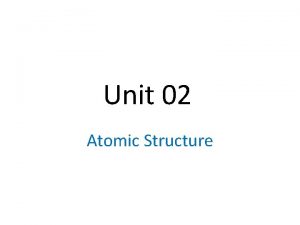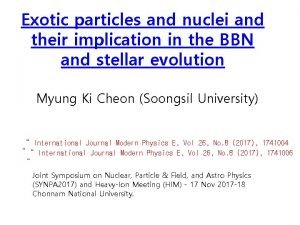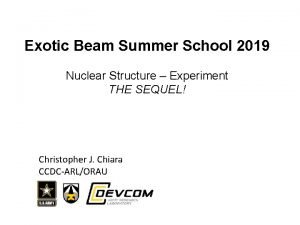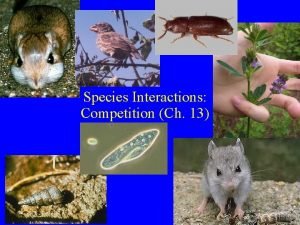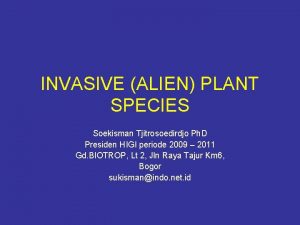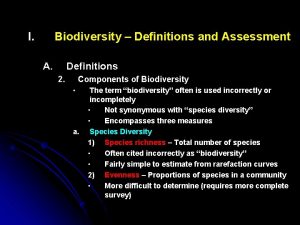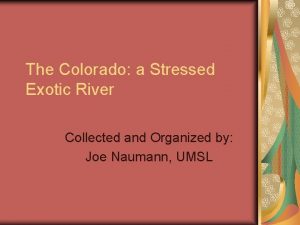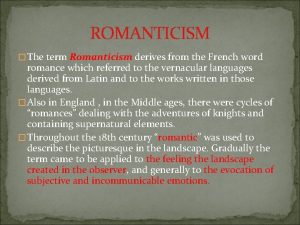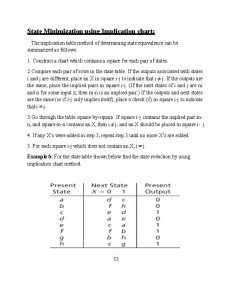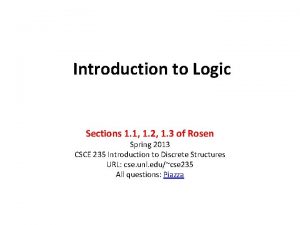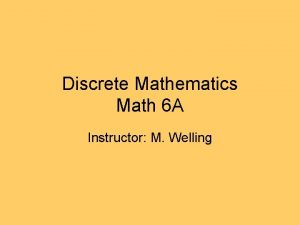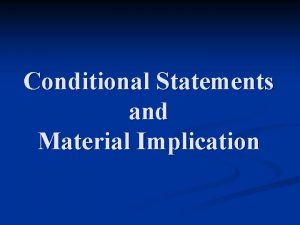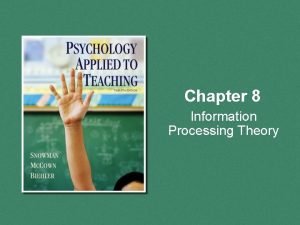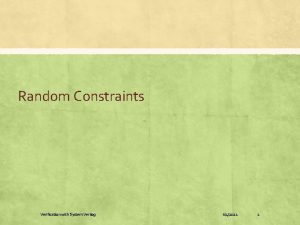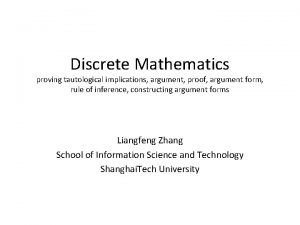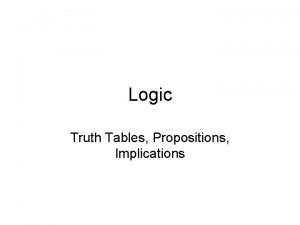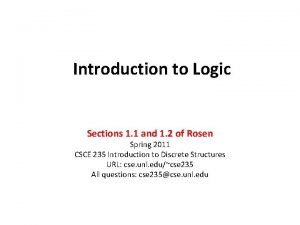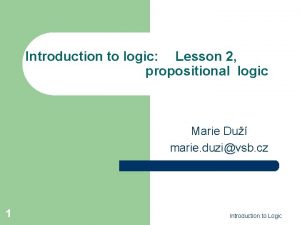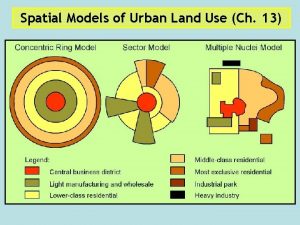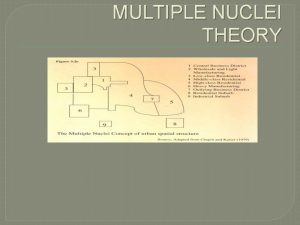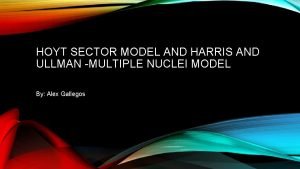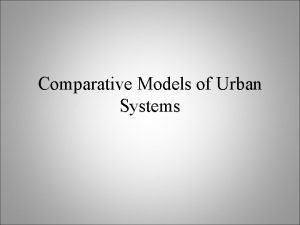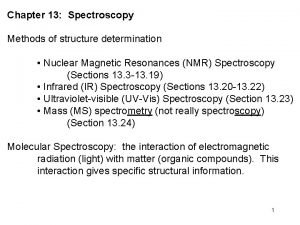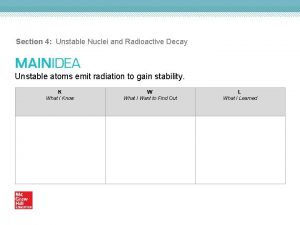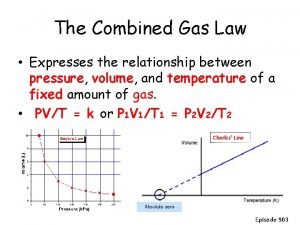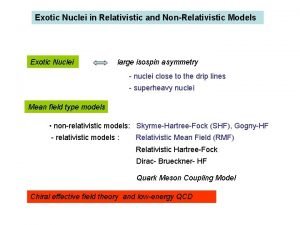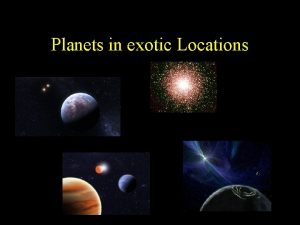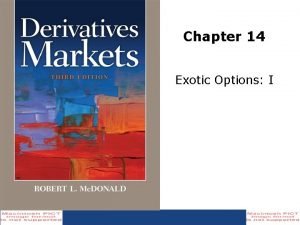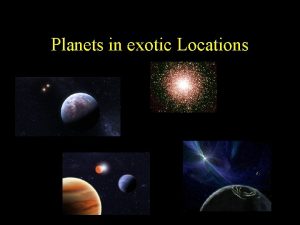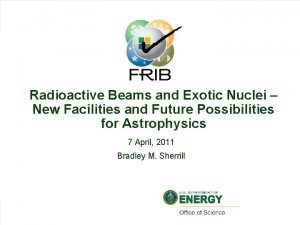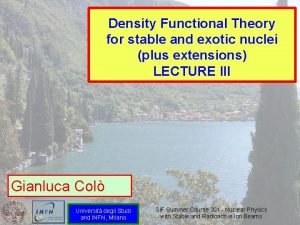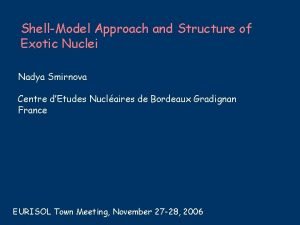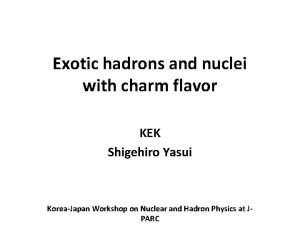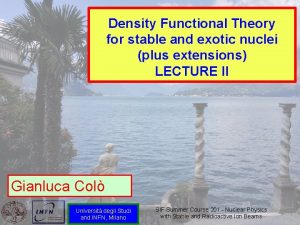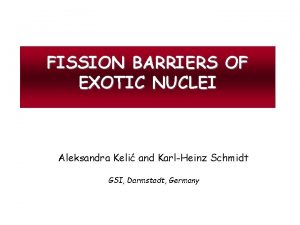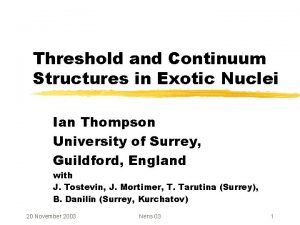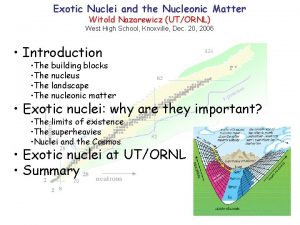Exotic particles and nuclei and their implication in







































- Slides: 39

Exotic particles and nuclei and their implication in the BBN and stellar evolution Myung Ki Cheon (Soongsil University) “ International Journal Modern Physics E, Vol 26, No. 8 (2017), 1741004 ”“ International Journal Modern Physics E, Vol 26, No. 8 (2017), 1741006 ” Joint Symposium on Nuclear, Particle & Field, and Astro Physics (SYNPA 2017) and Heavy-Ion Meeting (HIM) - 17 Nov 2017 -18 Chonnam National University.

1 -1. 연구 개요 및 목표 : 원소의 생성 과정 Supernova Nucleosynthesis in Neutrino-Driven Winds Ex Proton Number Z he oti av c N ily uc de lea pe r nd Str on uct Nu ure cle an ar d R M ea od ct el ion s s Movie by Chiba, Koura & Kajino 235 U 208 Pb 184 132 Sn 58 Ni 56 Fe 40 Ca 126 82 50 28 20 NRF Presentation, March 3, 2017 Neutron Number N 2

Nuclear chart simulation N=50 Z=50 N=28 N=20 Z=28 N=8 Z=20 Z=8 ISPUN, Sep. 25 -30, 2017, Halong Bay, Vietnam

X-particles in BBN

XBBN 5

I. Introduction 1. Thermal history of the universe ØBig Bang Theory It was hot in the early universe Signatures may be left on elemental abundances Big Bang 200 Me. V Quark Hadron Transition 1 -0. 01 Me. V Big Bang Nucleosynthesis (BBN) 0. 3 e. V Gauge boson Photon Exotic particles 0. 2 me. V Recombination of Nuclei with e. Decoupling of g and e- [Components] Leptons & quarks ħ=c=k. B≡ 1 1 Me. V=1. 1605× 1010 K Temperature Neutrino Background ? Abundances Observation! Any signature of new physics? Observation! 3 K Background 6

2. BBN Theory and observation ØStandard big bang nucleosynthesis (SBBN) parameter: baryon-to-photon ratio h ØObservation of CMB constraint on h WMAP 7 WMAP Science Team ØObservation of metal-poor stars (MPSs) ü 7 Li abundance is smaller than theory by a factor of ~3 Signature of new physics? Goals ØFind the solution of the 7 Li problem, & identify the processes in the early universe ØDerive constraints on particle models Kawasaki & MK, PRD 7 86, 063003 (2012)

3. Standard Big Bang nucleosynthesis (SBBN) Øn↔p equilibrium (n/p)EQ=exp(-Q/T) Q≡mn-mp=1. 293 Me. V Øt~1 sec, T=TF~1 Me. V(week interaction freeze-out) (1 Me. V=1. 16× 1010 K) ünn e+ egg ün↔p ü e± gg (T~me/3) Kawano code (1992) (n/p)freeze-out=exp(-Q/TF)~1/6 Rates…Smith et al. (1993) +Descouvemont et al. (2004) +Cyburt & Davids (2008) tn=881. 9 s (Mathews et al. 2005) 7 Li(p, a)4 He 7 Be 7 Li e--capture after recombination 6 Li(p, a)3 He T(a, g)7 Li 3 He(a, g)7 Be D(a, g)6 Li T 9≡T/(109 K) h=nb/ng=6. 3× 10 -10 WMAP(Dunkley et al. 2008) 8

Courtesy by W. Fowler 9

II. Effect of Negatively charged massive particle (CHAMP) on BBN ØCHAMP X- recombines with nuclide A, and X-nuclide (AX) forms (Cahn & Glashow 1981) X-nucleus X- Øexotic atoms form exotic nucleosynthesis nuclide A (Pospelov 2007, Kohri & Takayama 2007, Kawasaki et al. 2007 -, Hamaguchi et al. 2007, Jedamzik 2008 -, Kusakabe et al. 2007 -) üRecombination of X- and nuclide X- X- A üNuclear reaction of X-nuclide a X- A (e. g. De Rujula et al. 1990, Dimopoulos et al 1990) g A (e. g. Kohri & Takayama 2007) X- B b üresonant reaction via exotic atoms of 8 BX* (Bird et al. 2008; MK et al. 2007) p X- 7 Be X- 8 B* X- 8 B g ØImportant reactions related to 7 Be abundance g)7 Be. X 7 Be +p 8 B * 8 B +g X X X 7 Be(X-, (1) Another process for 7 Be. X formation 7 Be(e-, g)7 Be 3+(X-, e-)7 Be X 10 (MK, Kim, Cheoun, Kajino, Kino, PRD 88, 063514, 2013)

4. Nuclear reaction rate ØBinding energies of X-nuclei reaction Q-values, detailed balance ØReaction rates of X-nuclei are estimated with those of normal nuclei correcting for charge number and reduced mass ØWe adopt cross sections calculated with a quantum three-body model (Hamaguchi et al. 2007, Kamimura et al. 2008) ØImportant resonant reaction: p X- 7 Be energy (Me. V) X- 8 B 0. 166 X* X+p X- 8 B g a(n=2, l=1) atomic ES (Bird et al. 2007) 8 B*(1+) X atomic GS composed of nuclear ES and X(MK, Kajino, Boyd, Yoshida, Mathews, PRD 2007) 0. 117 7 Be 8 B* 0. 770 8 B 0. 819 X 2+ (m. X=∞) 12

3. Recombination cross section ØResonant and nonresonant cross sections for (7 Be, 7 Li, 9 Be, 4 He) Finite size of nuclear charge binding energies of tightly bound states are smaller than those of point-charges wave functions and recombination cross sections are also different ex ) 7 Be. X (m. X=1 Te. V) b. s. wfs s. s. wfs Nonresonant cross section ü Smaller binding energies of lower states The most important transition is d-wave 2 P state (cf. p-wave 1 S state for electronic ion case) inclusion of many transitions 13 rate is 6 times larger than previous result

4. Nuclear reaction rate ØBinding energies of X-nuclei reaction Q-values, detailed balance ØReaction rates of X-nuclei are estimated with those of normal nuclei correcting for charge number and reduced mass ØWe adopt cross sections calculated with a quantum three-body model (Hamaguchi et al. 2007, Kamimura et al. 2008) ØImportant resonant reaction: p ex) m. X=∞ X- 7 Be b. s. wfs (8 BX) X- 8 B* X- 8 B g Thermal reaction rates 14

Parameter search: case 1 (mx=1 Te. V) Contours of calculated Li abundance relative to the observed value: d(ALi)=ALi. Calc/ALi. Obs Lifetime 6 Li h=6. 19× 10 -10 production 7 Li reduction (WMAP 9 yr) Region for 7 Li reduction without 6 Li overproduction Abundance YX=n. X/nb ØRealistic parameter region is shifted to YX ≿ 0. 02 and t. X≈(0. 6 -3)x 103 s from the previous one: YX ≿ 1 and t. X≈(1 -2)x 103 s (MK et al. 2010)15

Parameter search: case 2 (mx=1 Ge. V) Contours of calculated Li abundance relative to the observed value: d(ALi)=ALi. Calc/ALi. Obs Lifetime 6 Li h=6. 19× 10 -10 production 7 Li reduction (WMAP 9 yr) Region for 7 Li reduction without 6 Li overproduction Abundance YX=n. X/nb ØParameter region for smaller mass cases locates at longer lifetime region: YX ≿ 0. 1 and t. X≈5 x 103 -2 x 105 s (for m. X=1 Ge. V) 16

Summary Ø We calculated light-element nucleosynthesis during BBN with negatively-charged X- particles dynamically. Ø New route of 7 Be. X formation (7 Be exchange between 7 Be 3+ and X-) Ø We calculated rates of recombination of X- and 7 Be, 7 Li, 9 Be, 4 He Ø New 9 Be production reaction [7 Li. X(d, X-)9 Be]. Ø Parameter region of 7 Li reduction is moved ü YX ≿ 0. 02 and t. X≈(0. 6 -3)x 103 s (for m. X=1 Te. V) required abundance of X- particle is smaller than the previous estimate by more than a factor of 10 Ø Resulting 7 Li abundance depends significantly on assumed nuclear charge distribution ü Energy levels of X-nuclides are affected by charge distribution resonant reaction rates are also affected 17

Sterile Neutrino

However, Four Experimental Anomalies Do Not Fit Within the 3 n Mixing Picture § LSND § Mini. Boo. NE § The Gallium Anomaly § The Short Base-Line Reactor Neutrino Anomaly These anomalies possibly suggest a fourth sterile neutrino, requiring a mass on the 1 e. V scale. However, there also complex nuclear physics issues associated with each anomaly.

Summary of MA experiments MA = 1. 03 ~ 1. 32 Ge. V ? RIKEN Seminar, Jan. 20, 2017 OPEN PROBLEM !

How to understand the origin of Sterile Neutrino ?

Sterile-active neutrino oscillations and shortcuts in the extra dimension [H. pas et al. , Phys. Rev. D 72, 095017 (2005)] Brane How does it affect the big bang nucleosynthesis?

The cosmic expansion rate in five-dimensional universe P. Binetrun et al. , Phys. Lett. B 477, 285 (2000) D/H : R. Cooke et al. , Astrophys. J. 781, 31 (2014) Yp : Y. I. Izotov et al. , Astron. Soc. 445, 778 (2014

The energy density of the sterile neutrino Rate equation The production rate of the sterile neutrino :

The effective mixing angle Geodesic Matter effect differences between bulk and brane Resonance energy


The result of the rate equation Contour Temperature evolution

BBN constraint


Nuclear Pasta in Neutron Star

Tsuyoshi Miyatsu, Myung-Ki Cheoun (Soong. Sil U. ), Koichi Saito (Tokyo U. of Sci. , Noda Campus). Ha. Phy, APCTP, Pohang, 13 -14 Oct. , Published in Astrophys. J. 813 (2015) no. 2, 2017 135


This nuclear pasta forms in the dense crust of a neutron star thanks to long-range repulsive forces competing with something called the strong force, which is the force that binds quarks together. In other words, two powerful forces are working against one another, forcing the matter – which consists of various particles – to structure itself in a scaffold-like (pasta) way. As one of the team, Greg Huber, a biological physicist from the University of California, Santa Barbara, explains: "When you have a dense collection of protons and neutrons like you do on the surface of a neutron star, the strong nuclear force and the electromagnetic forces conspire to give you phases of matter you wouldn't be able to predict if you had just looked at those forces operating on small collections of neutrons and protons. " Now, it turns out that these pasta-like structures look a lot like the structures inside biological cells, even though they are vastly different. This odd similarity was first discovered in 2014, when Huber was studying the unique shapes on our endoplasmic reticulum (ER) – the little organelle in our cells that makes proteins and lipids.

Particle Production in Strong Magnetic Field

BEYOND SYNCHROTRON RADIATION Ha. Phy, APCTP, Pohang, 13 -14 Oct. , 2017

Magnetar & SMa. F Axion Luminosity from Magnetar Axion–N, e Coupling Temperature Dependence of Axion Luminosity 1/100 of Max. Value N. Iwamoto, PRL 53, 1198 (84) Ha. Phy, APCTP, Pohang, 13 -14 Oct. , 2017 (ke. V)

Magnetar & SMa. F Axion Luminosity from Magnetar Density Dependence of Axion Luminosity DU MU SMa. F Dep. Ha. Phy, APCTP, Pohang, 13 -14 Oct. , 2017


4. 7 Li problem Ø 7 Li/H in MPSs < 7 Li/H in SBBN 7 Li/H=(1. 1 -1. 5)× 10 -10 fit of Li. I 6708 A line (Spite & Spite 1982, Ryan et al. 2000, Melendez & Ramirez 2004, Asplund et al. 2006, Bonifacio et al. 2007, Shi et al. 2007, Aoki et al. 2009, Sbordone 2010) log(Li/H)+12 Sbordone et al. (2010) Asplund 06 Aoki 09 7 Li SBBN Aoki et al. (2009) Li problem Sbordone 10 Gonzalez Hernandez 08 Old stars ~ primordial 43

4. 6 Li problem Ø 7 Li abundance observed in metal-poor stars are a factor~3 smaller than SBBN 7 Li/H=(1. 1 -1. 5)× 10 -10 log(6, 7 Li/H)+12 Asplund et al. (2006) 7 Li BBN Li problem Old stars ~ primordial Ø It has been reported that some of the stars have large abundances of 6 Li/H ≈ 6× 10 -12 ≿ 103 x 6 Li problem? 6 Li BBN Ø But, Lind et al. firstly perform -2. 0 3 D NLTE analysis for [Fe/H]=log{(Fe/H)/(Fe/H)8} atmosphere, and found News! Lind et al. Astron. Astrophys. (2013) no detection 44
 Three subatomic particles and their charges
Three subatomic particles and their charges Exotic species definition biology
Exotic species definition biology Nuclear pasta
Nuclear pasta Exotic breed of rabbits
Exotic breed of rabbits Exotic beam summer school
Exotic beam summer school Exotic species definition
Exotic species definition Woman walking in an exotic forest
Woman walking in an exotic forest Shannon wiener index definition
Shannon wiener index definition Exotic species definition
Exotic species definition Exotic species definition
Exotic species definition Exotic species definition
Exotic species definition Is the colorado river an exotic stream
Is the colorado river an exotic stream Ferrari rental houston
Ferrari rental houston Romsnticism
Romsnticism Static hedging of exotic options
Static hedging of exotic options Implication table
Implication table Implication elimination
Implication elimination Simple proposition
Simple proposition Propositional logic
Propositional logic Implications math
Implications math Material implication examples
Material implication examples Teaching implication of the information process
Teaching implication of the information process Verilog urandom
Verilog urandom Tautological implication
Tautological implication Truth table for implication
Truth table for implication Disjunction
Disjunction Components of mathematical system
Components of mathematical system Implication law
Implication law Implies in propositional logic
Implies in propositional logic Implication for practice
Implication for practice In fair verona where we lay our scene translation
In fair verona where we lay our scene translation Harris and ullman multiple nuclei model example
Harris and ullman multiple nuclei model example Homer hoyt sector model
Homer hoyt sector model Multiple nuclei model assumptions
Multiple nuclei model assumptions Who made the sector model
Who made the sector model Difference between sector model and multiple nuclei model
Difference between sector model and multiple nuclei model Harris and ullman multiple nuclei model
Harris and ullman multiple nuclei model Nmr active and inactive nuclei
Nmr active and inactive nuclei Unstable nuclei and radioactive decay
Unstable nuclei and radioactive decay Charles gas law
Charles gas law
